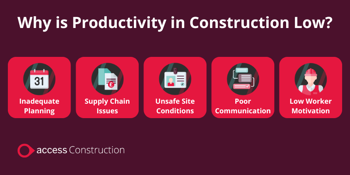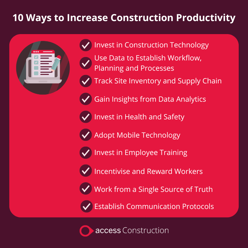How to Improve Productivity in the Construction Industry
It is no secret that construction is an industry vulnerable to mismanagement and inefficiency. Issues such as the labour skills gap and a sharp increase in hostile weather events continue to impact productivity.
However, action can be taken by construction companies to improve productivity. This article covers ten top strategies for improving productivity in the construction industry.
Top ten strategies for improving productivity in the construction industry
- Invest in Construction Technology
- Use Data to Establish your Workflow, Planning and Processes
- Track Your Site Inventory and Supply Chain
- Gain Insights from Data Analytics
- Invest In Construction Worker Health and Safety
- Adopt Mobile Technology
- Invest in Employee Training and Reskilling
- Establish Communication Protocols – and Stick to Them
- Incentivise and Reward Workers
- Work from a Single Source of Truth
In 2017, a groundbreaking report on construction productivity by The McKinsey Global Institute revealed that worldwide productivity in construction has been largely stagnant for decades. Six years on, the 2nd annual RICS report on global construction productivity uncovered that construction remains one of the lowest industry sectors in terms of labour productivity.
What is Productivity in the Construction Industry?
In short, productivity is a measurement of how efficiently a construction company gets things done. This includes both efficiency (getting the most work done with as little waste of labour, materials and equipment) and output vs input (the ratio of work completed vs the labour and resources used).
The 2024 RICS report on construction productivity digs deep on how productivity can be measured across construction, uncovering that there are multiple ways in which productivity can be tracked.
Examples include –
- Output per worker hour
- Productive worker time per total worker time
- Value of work completed per worker hours
- Value of work completed per worker costs
- Earned value over the actual cost
One of the reasons construction productivity runs so low (especially compared to manufacturing) is that every construction project is unique, compared to manufacturing where focus on improving productivity is based on creating a single product, construction projects have a vast range of inputs which change project-to-project.
What Affects Productivity in Construction?
A large range of factors affect productivity in construction, with factors differing across industries and projects.
Leading factors that affect productivity in construction include:
- Poor Planning – from inaccurate estimates to inflexible schedules, spending less time in the planning phase of the construction lifecycle will often pay back in decreased productivity as projects are impacted by rework and delays.
- Supply Chain Issues – The construction supply chain has seen more disruptions than usual over the past decade due to issues like Brexit, inflation and the War in Ukraine. Materials can arrive late, or not be sufficient quality, leading to a downturn in productivity.
- Site Conditions – Health and safety continues to be a leading issue in construction, and unsafe sites where workers are vulnerable to accidents or ill health impacts on productivity.
- Communication – A significant amount of delays and rework in construction is chalked down to poor communication – a mish-mash of lost email threads, phone calls and even WhatsApp messages can lead to essential information getting lost during a project.
- Worker Motivation – Workers in construction can become unhappy and unmotivated if working on an unsafe, poorly managed site.
These are just a few factors that have led to stagnant productivity in construction. Though there isn’t one ‘fix-all’, here are ten of the best ways to tackle productivity issues within a construction business.

Strategy 1: Invest in Construction Technology
Construction remains one of the least digitised industries in the world. While the industry very much deals in the physical, implementing construction management software solves many of the issues that leads to dips in productivity. Where nearly other industry has seen increases in productivity, construction continues to see little change. One of the key differences is a willingness to adapt to new technologies.
Technology allows construction businesses to share information on one platform, significantly cutting communication errors. It allows project managers and site supervisors to keep track of a project and identify issues while planning ahead. Workforce management software leads to a happier workforce when their issues are resolved faster.
While technology alone won’t fix productivity in construction, it has the potential to increase efficiency across every step of the construction lifecycle.
Read more about how to apply digital transformation within the construction industry.
Boost Productivity With Construction Management Software
Access Construction’s two leading products – Access Coins ERP and Access ConQuest Estimating – are both built to transform productivity across every step of the construction lifecycle.
Strategy 2: Use Data to Establish your Workflow, Planning and Processes
Organisation is key, and though planning can be time-consuming, especially when projects can develop quickly, establishing proper workflows and processes as part of the planning phase of a project can lead to a boost in productivity down the line.
Planning is made much easier if a construction business has a handle on their data. Building Information Modelling (BIM) software is an incredibly useful tool that turns complex data into a 3D model of your project. Construction estimating software uses data to quickly produce accurate estimates, and construction project management software helps project planners gain an overview of labour, equipment and resources to ensure a smoother, more productive build.
Strategy 3: Track Your Site Inventory and Supply Chain
An organised job site is a more productive one, and one of the keys to this is prioritising tracking on-site inventory. On-site productivity relies on available materials, equipment and tools. Supplies need to be replenished before they run out, the right tools need to be available for the right workers, and waste needs to be avoided.
An inventory needs to be kept and regularly updated to avoid days where workers have nothing to build with, or are spending time hunting down the equipment they need to do their job. Project managers and supervisors also need tools to keep track of their inventory, such as construction management software to help track materials and assets.
Strategy 4: Gain Insights from Data Analytics
Construction projects produce a lot of data. The majority of this is siloed across spreadsheets and not used at all. The ‘Big Data’ revolution in technology allows construction businesses to integrate thousands of data points and automatically analyse that data. The result? Insights into projects that will positively impact on productivity.
For example, insights from historical financial data can help construction companies forecast budgets and profits around future projects. Workforce attendance data can be analysed to gain insights into labour inefficiencies and hiring strategies.
Data is one of the construction industry’s great untapped resources, and tackling and integrating data across your project lifecycle will give your business the competitive – and productive – edge.
Strategy 5: Invest In Construction Worker Health and Safety
The 2023 HSE report on construction health and safety in the UK highlights how vulnerable construction workers are in the workplace. Alongside injuries and fatalities, over 69,000 construction workers are afflicted with work-related ill health. This equates to 2.6 million working days lost due to ill health and injury.
The impacts on productivity are obvious, and investment in health and safety measures – whether that is signage, protective equipment and specialised training, will pay off in multitudes. Not only does preventing injury and illness impact positively on productivity, but it also gives employees a sense of trust and confidence which helps with both worker retention and satisfaction – both impacting positively on productivity.
Learn more about health and safety construction courses available at The Access Group.
Strategy 6: Adopt Mobile Technology
Communication can be very tough on construction sites. They are loud and busy places with a mix of project managers, contractors and subcontractors working disparately. One of the most effective fixes is to equip workers with mobile technology where workers can be easily communicated with, and input their own communications.
Mobile applications are also the best way to link the back office to the job site, ensuring both sides are updated. Construction ERP software often comes with mobile applications for those on-site to remain updated about deliveries, orders, schedules and any delays and errors. Those on-site can also quickly input data and updates to retain visibility across projects.
This easy and accessible form of communication helps avoid project delays and boosts productivity on any construction project.
Strategy 7: Invest in Employee Training and Reskilling
Employees who know what they are doing will get the job done faster. Employee training brings increased motivation and confidence to construction workers, any construction company’s most valuable asset.
Investing in regular training helps construction workers both advance their own skills and add value and productivity to your company. It is also valuable to upskill and reskill employees for both improving productivity and their own increased job satisfaction.
The construction workforce is currently seeing a demographic shift, with many aging out of the workforce and leaving a labour skills gap. Instead of spending time and money on recruitment and onboarding, current workers can be trained in both a wider range of skills and new technologies. This helps retain a more stable, happier and productive workforce.

Strategy 8: Establish Communication Protocols – and Stick to Them
Poor communication is a leading cause of low productivity in construction, and it is one of the easier issues to fix. Project managers need to establish consistent communication lines and methods across a project, and ensure that these are followed.
This can be made easier through project management software or a larger construction management software system where members of a project team can communicate on a single platform. It is also vital that those on the job site and those in the office are also using the same communication lines.
Strategy 9: Incentivise and Reward Workers
Manual construction work is incredibly tough, and productivity can run low if morale is low. Construction companies can help those working on-site remain productive by clearly communicating their work is valued through incentives and rewards.
This can include performance-based bonuses, flexible scheduling, profit sharing and even simple positive reinforcement. Those who feel their hard work is being acknowledged and fairly reworded are incentivised to continue performing well.
By implementing a well-designed incentive and reward program, construction companies can create a win-win situation. Workers feel valued and motivated, leading to increased productivity and a more successful project overall.
Learn more about improving relationships with construction subcontractors.
Strategy 10: Work from a Single Source of Truth
Construction projects suffer when data is siloed. Any source of data can affect another, including documents, contracts, cost data, inventory and budget. This leads to stakeholders having only part of the information they need, but never the full picture. Productive construction companies work from a ‘single source of truth’ for data. A centralised hub holding budgets, schedules and communication can transform the productivity of a construction company.
Time wasting finding information and confusion caused by conflicting data and errors is eliminated, and every member of a project team is reading from the same page. This leads to fast and intelligent decision-making and a reduction in costly miscommunications which can lead to delays and rework.






